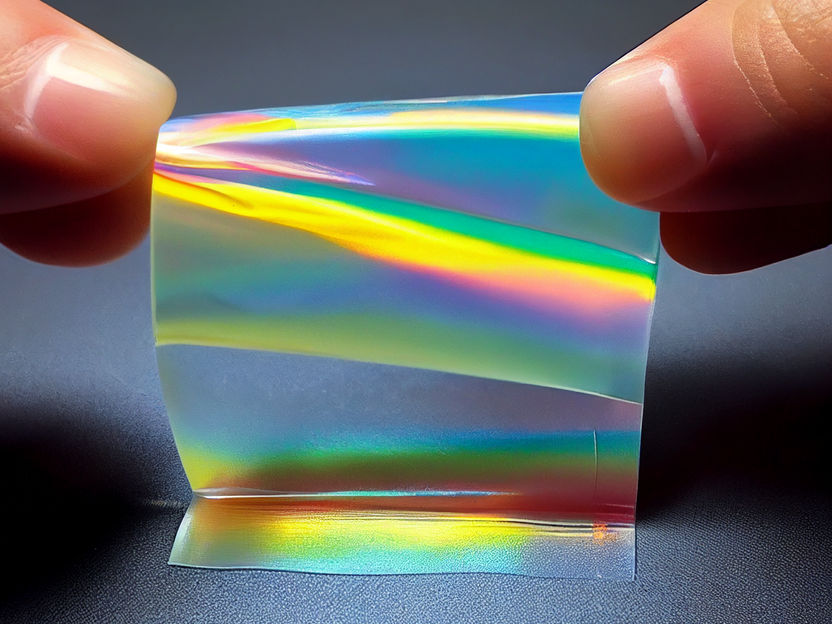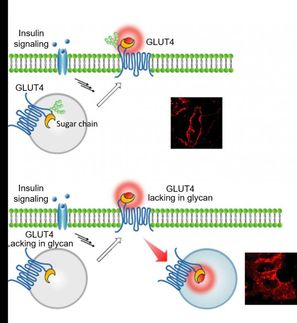Distinguish sugars with eye-catching and stretchy rainbow film
Rainbows and sugar may conjure up images of a certain leprechaun-branded breakfast cereal. But now, researchers in ACS Nano report a kaleidoscope-like film for telling different sweeteners apart that displayed multiple colors when stretched by hand. When evenly stretched with a simple apparatus, the material enhanced the unique shifts in fluorescence intensity of 14 sugars tagged with a dye, distinguishing between them in beverages and sweat samples.

symbolic picture
Computer generated picture
Sweet tastes in drinks can come from many types of sugar, including sucrose, fructose and glucose, as well as less common ones, such as maltose. There are also sugars in people’s sweat, which could be tracked to noninvasively monitor blood sugar. It’s hard to tell which molecules are present based on taste or look alone; instead, they’re usually identified with complex methods and sophisticated instruments. To simplify the detection process, Fengyu Li and colleagues previously used photonic crystals — polystyrene nanospheres whose color shifts when sugary compounds are nearby — in a color-changing chip sensor that distinguished 12 different sugars from one another. But these sensors weren’t wearable, so, Li, Chunbao Li and a new team wanted to incorporate photonic crystals into a stretchable easy-to-carry film and see whether the rainbow-colored platform could also detect and differentiate sugars.
The researchers embedded closely packed, ordered rows of polystyrene nanospheres into a film of polyethyl acrylate. Initially, the gummy material looked red, but when it was stretched with a uniform force, its color shifted through the rainbow — red to pink to orange to yellow-green to light green and, finally, dark green at a 40% stretch. And when pulled by hand, the material produced a kaleidoscope of colors, as different parts of the material had different forces on them.
In initial experiments, the researchers showed that stretching the film enhanced the fluorescent signals from 14 sugars that had been attached to dyes. These signals could then be sorted from one another. To see if the sensor could do the same with real-world samples, they mixed six commercially available drinks with the dye alizarin red S-2-diphenylboronic acid 2-aminoethyl ester, creating fluorescent complexes. Solutions with these complexes were dotted onto the film, which was then stretched, and the fluorescence intensities were measured at two different wavelengths of light. And because each samples’ sugar-dye complexes produced unique signals, they could be distinguished from each other. The sensor also differentiated sweat samples from six people. Based on these results, the researchers say that the stretchable, multicolored material could be incorporated into wearable devices for environmental, clinical or health monitoring of sugar, or modified to detect other substances.
The authors acknowledge funding from the National Natural Science Foundation of China.
Original publication
Other news from the department science

Get the analytics and lab tech industry in your inbox
By submitting this form you agree that LUMITOS AG will send you the newsletter(s) selected above by email. Your data will not be passed on to third parties. Your data will be stored and processed in accordance with our data protection regulations. LUMITOS may contact you by email for the purpose of advertising or market and opinion surveys. You can revoke your consent at any time without giving reasons to LUMITOS AG, Ernst-Augustin-Str. 2, 12489 Berlin, Germany or by e-mail at revoke@lumitos.com with effect for the future. In addition, each email contains a link to unsubscribe from the corresponding newsletter.























































